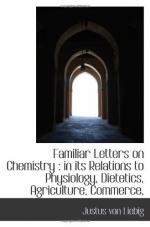The analysis of lapis lazuli represented it to be composed of silica, alumina, and soda, three colourless bodies, with sulphur and a trace of iron. Nothing could be discovered in it of the nature of a pigment, nothing to which its blue colour could be referred, the cause of which was searched for in vain. It might therefore have been supposed that the analyst was here altogether at fault, and that at any rate its artificial production must be impossible. Nevertheless, this has been accomplished, and simply by combining in the proper proportions, as determined by analysis, silica, alumina, soda, iron, and sulphur. Thousands of pounds weight are now manufactured from these ingredients, and this artificial ultramarine is as beautiful as the natural, while for the price of a single ounce of the latter we may obtain many pounds of the former.
With the production of artificial lapis lazuli, the formation of mineral bodies by synthesis ceased to be a scientific problem to the chemist; he has no longer sufficient interest in it to pursue the subject. He may now be satisfied that analysis will reveal to him the true constitution of minerals. But to the mineralogist and geologist it is still in a great measure an unexplored field, offering inquiries of the highest interest and importance to their pursuits.
After becoming acquainted with the constituent elements of all the substances within our reach and the mutual relations of these elements, the remarkable transmutations to which the bodies are subject under the influence of the vital powers of plants and animals, became the principal object of chemical investigations, and the highest point of interest. A new science, inexhaustible as life itself, is here presented us, standing upon the sound and solid foundation of a well established inorganic chemistry. Thus the progress of science is, like the development of nature’s works, gradual and expansive. After the buds and branches spring forth the leaves and blossoms, after the blossoms the fruit.
Chemistry, in its application to animals and vegetables. endeavours jointly with physiology to enlighten us respecting the mysterious processes and sources of organic life.
LETTER II
My dear Sir,
In my former letter I reminded you that three of the supposed elements of the ancients represent the forms or state in which all the ponderable matter of our globe exists; I would now observe, that no substance possesses absolutely any one of those conditions; that modern chemistry recognises nothing unchangeably solid, liquid, or aeriform: means have been devised for effecting a change of state in almost every known substance. Platinum, alumina, and rock crystal, it is true, cannot be liquified by the most intense heat of our furnaces, but they melt like wax before the flame of the oxy-hydrogen blowpipe. On the other hand, of the twenty-eight gaseous bodies with which we are acquainted, twenty-five may be reduced to a liquid state, and one into a solid. Probably, ere long, similar changes of condition will be extended to every form of matter.




